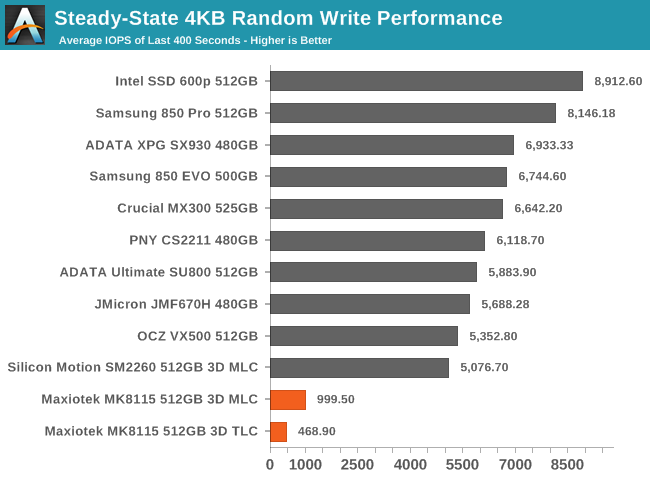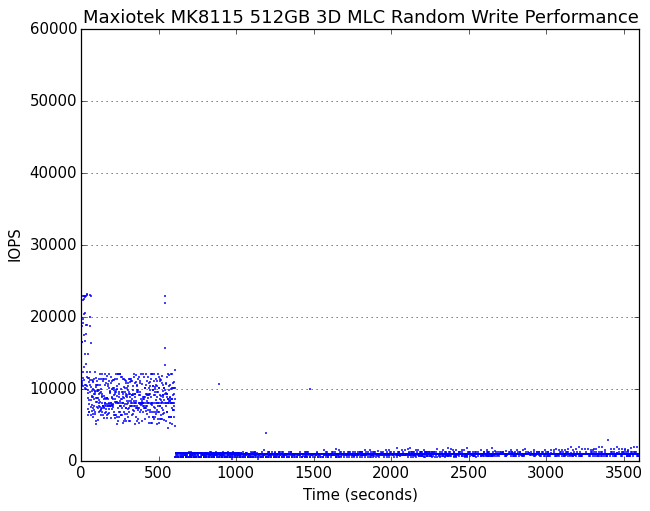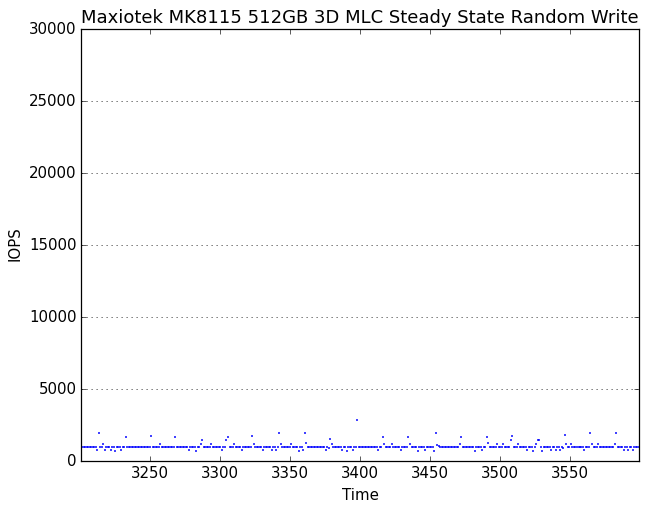Previewing Maxiotek's MK8115 SSD Controller: Can DRAM-less Drives Make The Cut?
by Billy Tallis on May 9, 2017 8:00 AM ESTPerformance Consistency
Our performance consistency test explores the extent to which a drive can reliably sustain performance during a long-duration random write test. Specifications for consumer drives typically list peak performance numbers only attainable in ideal conditions. The performance in a worst-case scenario can be drastically different as over the course of a long test drives can run out of spare area, have to start performing garbage collection, and sometimes even reach power or thermal limits.
In addition to an overall decline in performance, a long test can show patterns in how performance varies on shorter timescales. Some drives will exhibit very little variance in performance from second to second, while others will show massive drops in performance during each garbage collection cycle but otherwise maintain good performance, and others show constantly wide variance. If a drive periodically slows to hard drive levels of performance, it may feel slow to use even if its overall average performance is very high.
To maximally stress the drive's controller and force it to perform garbage collection and wear leveling, this test conducts 4kB random writes with a queue depth of 32. The drive is filled before the start of the test, and the test duration is one hour. Any spare area will be exhausted early in the test and by the end of the hour even the largest drives with the most overprovisioning will have reached a steady state. We use the last 400 seconds of the test to score the drive both on steady-state average writes per second and on its performance divided by the standard deviation.

No, that's not a mistake. The abysmal steady-state performance of both MK8115 prototypes is a consequence of not having a cache for the logical to physical address mapping. Each write in this test is overwriting an in-use logical block address. While the controller's wear leveling ensures that the new data will go to a new location (the physical address of which is probably kept in a register on the controller), the controller has to read from the flash to figure out which physical page just got invalidated and became a candidate for garbage collection. Meanwhile, the garbage collection process has to scan the flash instead of a DRAM cache in order to determine if all the pages in an erase block contain stale data or if there's some live data that needs to be moved before the controller can erase that block.
This test isn't easy for any consumer SSD, but a DRAM-less SSD suffers acutely. Still, in spite of all the barriers to efficient flash management, the MK8115 drives are faster than a hard drive.

The MK8115 samples have poor steady-state throughput, but their consistency is pretty good. Maxiotek has ensured that the garbage collection never completely stalls the drive's progress on completing host write operations.
 |
|||||||||
| Default | |||||||||
| 25% Over-Provisioning | |||||||||
Before the MK8115 SSDs run out of spare area, their random write speeds aren't horrific, and are better than what most SSDs manage in steady state. It's only when the spare area runs out that the MK8115 gets into serious trouble. The TLC drive takes longer to reach this point, because the odd 48GB capacity of Micron's 3D TLC forced Maxiotek to give the drive much more overprovisioning than a typical 512GB SSD.
 |
|||||||||
| Default | |||||||||
| 25% Over-Provisioning | |||||||||
There is some cyclical behavior in the steady state of the MK8115 drives, but less than for most SSDs. The MLC drive in particular is extremely consistent save for periodic but very short bursts of higher performance.










60 Comments
View All Comments
jardows2 - Tuesday, May 9, 2017 - link
I fondly remember when new developments in SSD products resulted in lower prices AND better performance. Now it seems that every new product is geared only for lower prices, and the performance is getting worse! Not to mention that the prices have gone up substantially in the past year, I don't think we are at the best value time for SSD's.MajGenRelativity - Tuesday, May 9, 2017 - link
Can you provide evidence of performance getting worse? I haven't seen groundbreaking performance strides in anything but high-end/upper-mid (Samsung 960 series), but I haven't seen a performance regression.Sonic01 - Tuesday, May 9, 2017 - link
i actually found this today, i was looking for a new budget 1tb SSD.my current is a crucial m500 from 2013 i bagged for about £450, now the cheapest 1tb ss'd are about £300 but overall performance is about 30% of the m500..... in 4 years they have dropped 30% of the cost at the expense of 60% of the speed...
MajGenRelativity - Tuesday, May 9, 2017 - link
I looked on amazon.co.uk and the Samsung 850 Evo is 300 for 1TB. I also paged around in Anandtech reviews, and it has better performance than the M500, sometimes significantly so. The MX300 is 250 for 1TB, and it also scores very well on reviews, although I didn't do a very thorough comparison to the M500, it seems a little lower in performance compared to the 850Evo, which should still put it slightly ahead of the M500AlphaBlaster - Sunday, May 14, 2017 - link
That embecil Comey wanted to grab and be in the headlines, and he was manipulating evidence, etc ,and non-evidence, etc.to accomplish that. That's just one thing. He has no integrity. He showed himself to be just another Washington stooge. Hoover was also another Washington stooge and a degenerate, but was fired by the president that committed the crime that he fired Hoover for. If some entity could lob a couple of nukes onto Washington DC when whatever worthless miscreant president at the time is addressing both houses of congress, it would be a blessing!CheapSushi - Wednesday, May 10, 2017 - link
The big difference is the Crucial M500 is MLC NAND and the Samsung 850 EVO and similar cheaper ones are TLC NAND. TLC is inherently slower than MLC; always. It's 2 bits per cell vs 3 bits per cell. It's an important distinction when comparing SLC, MLC, TLC and soon QLC. Maybe you didn't know?extide - Wednesday, May 10, 2017 - link
Yeah, but the 850 is also using #d TLC, not planar TLC, and 3D TLC is a lot faster than planar TLC. Maybe you didn't know?extide - Wednesday, May 10, 2017 - link
#d is supposed to be 3D, of courselowlymarine - Wednesday, May 10, 2017 - link
If only the very site you were on had some sort of database of benchmarks you could check to see that, in fact, the 850 EVO is massively faster than the M500. Oh hey, look what I found! http://www.anandtech.com/bench/product/805?vs=1398MajGenRelativity - Thursday, May 11, 2017 - link
The 850 Evo is faster though, so I'm not sure what you're trying to say